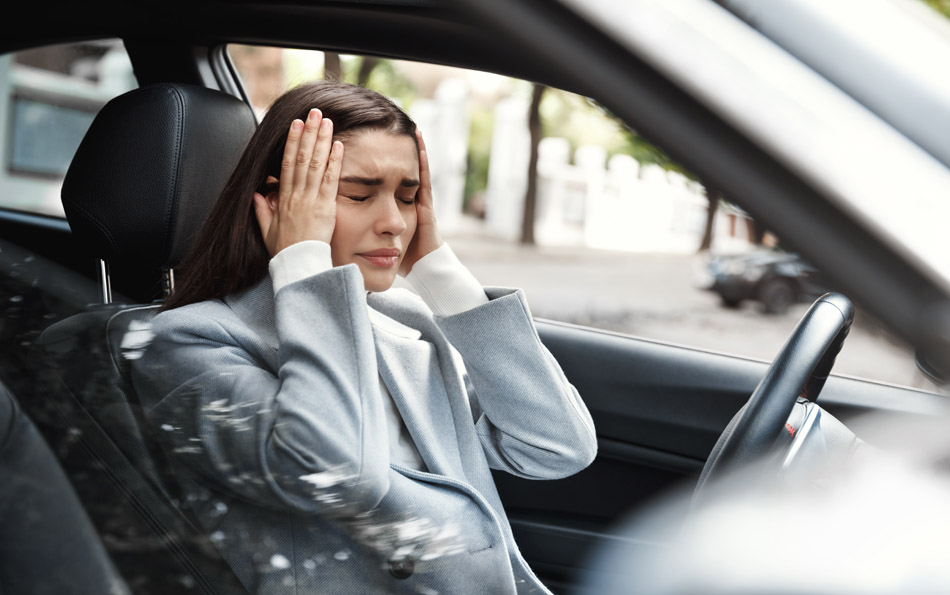Panic Attack While Driving: 4 Ways to Calm Anxiety
Feeling anxious while driving is common for many people. This can lead to panic attacks that seem to worsen the longer you’re in the car. We provide common signs to look out for, reasons for high anxiety levels, and ways you can cope with panic attacks while driving.

Being out on the road can be a challenging experience.
You might feel nervous driving independently or going to new locations. These are normal fears that may turn into full-blown panic attacks throughout the day. A panic attack could trigger physical symptoms that hinder your ability to drive and think clearly when out on the road.
There are several ways you can ease panic attacks while driving. This is very important in stopping you from losing control of the wheel. You can learn a few relaxation techniques that reduce panic attack symptoms and encourage the brain to focus on driving safely.
In this article, you’ll discover how to deal with panic attacks while driving.
How to Deal With a Panic Attack While Driving
- Start breathing slowly
- Distract yourself
- Overcome your fears
- Try cognitive behavioral therapy (CBT)
Panic Attack While Driving: What Are the Signs?
A panic attack derives from feelings of intense fear, worry, and discomfort. You might feel like anxiety is completely taking over your thoughts. The body reacts to extreme stress and causes heart palpitations, excessive sweating, and shortness of breath.
People sometimes struggle to drive on their own or navigate new environments. This is because driving is an independent task that requires dedication, precision, and practice. Feeling nervous at the thought of being in your car alone could increase the risk of sudden panic attacks.
You may have certain triggers you don’t even know about. Some might be the sound of other cars on the road or smells associated with a previous panic attack. It’s important to stay aware of these signs to prevent panic attacks and gain full concentration while driving.
A study found that driving anxiety has both physical and psychological effects. Paranoid thoughts could focus on crashing or being injured on the road while your body tries to calm your heart. This leads to a range of symptoms that overwhelm you and cause a panic attack.
Below are some signs of a panic attack:
- Heart palpitations
- Rapid heart rate
- Sweating
- Trembling
- Struggling to breathe
- Choking sensation
- Pain in chest
- Stomach discomfort
- Nausea
- Disorientation
- Sense of impending doom
How do you know if you’re having an anxiety attack?
Some people may experience different symptoms when suffering from anxiety. This can depend on your age, gender, and current mental state. Most people get excessive sweating, shortness of breath, and clammy palms when having an anxiety attack.
You should seek professional help if you can’t identify anxiety attacks on your own. A doctor will question your symptoms and understand more about your mindset. Not everyone can pinpoint recurring anxiety attacks or determine when they’re going to happen in their everyday lives.
Just remember that you are more likely to have anxiety symptoms beforehand. These might be chest pain or tightness that won’t go away. Research shows that your breathing changes during times of stress, which puts more pressure on your chest muscles and causes pain.
Here are some common signs of an anxiety attack:
- Sweating
- Rapid heart rate
- Shortness of breath
- Lightheadedness
- Nausea
- Chest pain
- Dry mouth
- Trembling hands
- Heart palpitations
Anxiety attacks tend to last for about 10 minutes; however, some people may experience different symptoms for up to 30 minutes.
What Can Cause Panic Attacks While Driving?
There are many plausible reasons for panic attacks during a drive. You might fear bridges, tunnels, complicated roads, or other drivers. Being on the road can be a daunting experience that may convince you that a car crash will happen.
Of course, not everyone fears driving on their own. Going through extreme stress or anxiety could put you at a higher risk of experiencing panic attacks. You might encounter bad drivers, roadworks, adverse weather changes, or problems on the road that make you more stressed.
Someone with a panic disorder is more likely to get a panic attack that makes them feel detached. This disorder is the intense reaction to fear and anxiety in your everyday life. Frequent and unexpected panic attacks can occur anywhere, even when you feel confident driving.
Problems with your vision could be another factor. Not seeing clearly at night or feeling overwhelmed by external lights might feed the panic disorder. If you struggle with this regularly, avoid driving for a while and speak to mental health professionals about treatment.
Be aware that self-destructive behavior will only fuel panic attacks. Constantly dragging down your achievements could make you feel less capable of driving. Always speak to a doctor about dealing with a panic disorder and how to find the best coping strategies for your health.
How Are Panic Attacks Diagnosed?
A mental health professional will ask about your medical history and symptoms. They might talk about your panic attack experience. This gives you a chance to express any psychological or physical symptoms that seem to make your panic attacks worse.
Some doctors like to rule out other health problems first. This is to ensure you don’t have any heart or thyroid problems that share similar symptoms to panic attacks. You might get a blood test before a real diagnosis and an electrocardiogram reading to monitor your heart.
People often experience 4 or more symptoms when having a panic attack. It’s very important to share this vital information with a mental health professional in order to get the best treatment possible.
4 Ways to Cope with Panic Attacks While Driving
There are things you can do to settle panic attacks in the car. You should learn more about calming methods to reduce any physical or emotional symptoms. Remember to practice these strategies and converse with your doctor about finding other suitable anxiety treatments.
Here are 4 ways to cope with panic attacks:
#1 Start breathing slowly
Panic attacks may cause uncontrollable breathing. This can be a scary thing to experience when you struggle to calm down. You should try certain breathwork exercises and follow the 333 rule that can help get your breathing under control by focusing your attention on the breath, what you see, hear, and touch.
Take a deep breath in, hold it for 5–10 seconds, and slowly exhale. It might be hard to begin when your mind is all over the place but focus on your breathing first. Getting back to a normal state is a great way to settle the panic attack and prevent it from worsening.
You could also make sure to park somewhere safe and sit comfortably in the seat. Put your head back and take a deep breath. Focus on something in the distance to distract your mind. This should help slow your breathing naturally since you’re not thinking about driving anymore.
#2 Distract yourself
Listening to music or podcasts can keep you distracted from bad thoughts.
A study found that music positively affects the human stress response. Your body stops releasing cortisol and focuses on producing more oxytocin. This hormone is related to happy feelings that make you feel more energetic and joyful during positive moments.
Podcasts are also an immersive experience that catches your attention. You could listen to something fascinating to dull the extreme fear of driving. It might even help to choose audios that talk about panic disorder and ways you can prevent a panic attack in the future.
#3 Overcome your fears
Learning to overcome fears that completely overwhelm you could be key to preventing panic attacks while driving. Consider facing that fear head-on to discover more about it. Pushing anxious feelings to the dark side of your mind will only increase the risk of a panic attack.
Grab a journal and document your experiences over the next 2–3 weeks. You might write down common panic disorder symptoms that occur just before panic attacks. These are important signs to look out for when battling your fears and staying in control of your own emotions.
#4 Try cognitive behavioral therapy (CBT)
Cognitive behavioral therapy (CBT) is a form of psychological treatment that helps you better understand your thoughts, feelings, and actions. A mental health counselor aims to break down things that scare you so you can properly live your life in peace.
A Word From a Psychologist
Some people struggle with driving-related panic attacks and common anxiety disorders. Learning to navigate the road and be independent is a challenging thing to overcome. This is why you might avoid getting into a car or even taking driving lessons in the first place.
You can go for morning walks, quick jogging sessions, or runs to reduce stress. A study found that exercise reduces anxiety symptoms and helps to prevent severe panic attacks. Even going outside for 10 minutes every day could stop your stress levels from getting too high.
Consult with a doctor if you feel like the panic attacks are getting worse. A medical professional can prescribe the right treatment or refer you to a specialist. Remember that it takes time to overcome driving anxiety, especially if you’re new to being outside in a new environment.
Conclusion
Getting a panic attack while you’re driving can be scary. You might feel like you can no longer drive or be responsible when out on the road. Simple breathing exercises and cognitive behavioral therapy techniques could help you overcome any driving anxiety.

















































 Select your language:
Select your language: 








